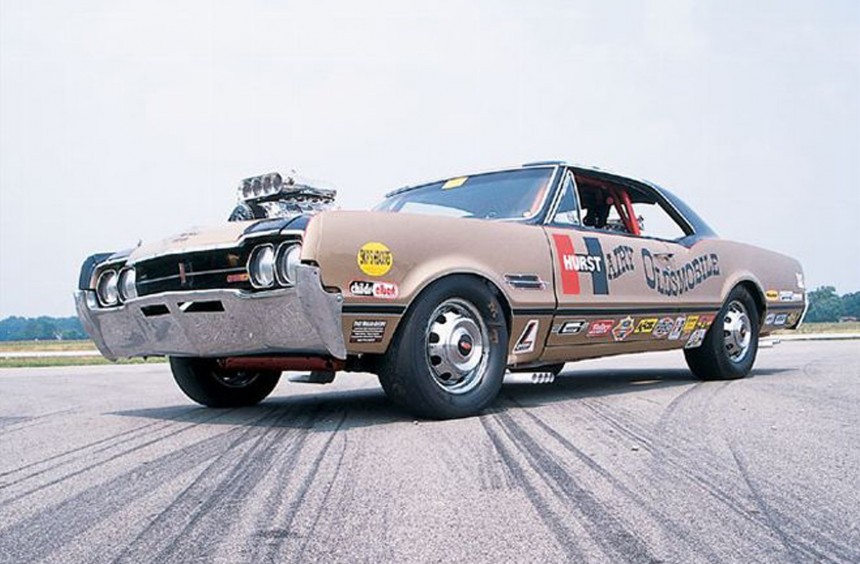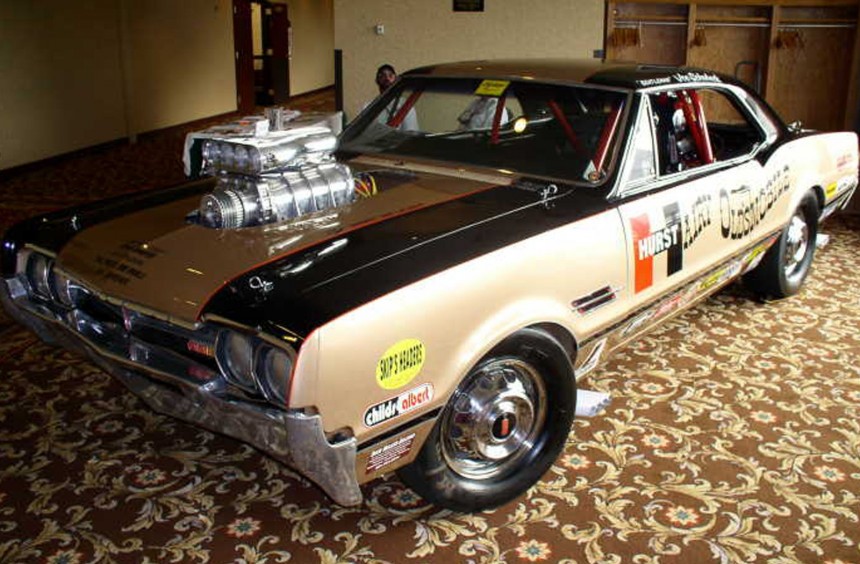During the glory days of muscle cars, Hurst Performance teamed up with Oldsmobile to create probably one of the most insane promotional cars of all time, the tire-shredding, twin-engined Hurst Hairy Olds.
Founded in 1958 by two young enthusiasts, George Hurst and Bill Campbell, the company, initially called Hurst-Campbell, started as an auto repair shop.
By the early 1960s, it became an aftermarket manufacturer called Hurst Performance, which was revered among car enthusiasts for its innovative gear shifters. In the following years, Hurst shifters became OEM components that came with the era's most impressive muscle cars straight from the factory.
Hurst didn't stop there. In addition to its famous shifters, the company began manufacturing other muscle car-oriented components. In 1968, it joined forces with GM's Oldsmobile division and helped create the iconic special-edition 442 called Hurst/Olds. Then, it helped AMC develop two of its most famous muscle cars, the 1969 SC/Rambler and the 1970 Rebel Machine.
But, before it lent a hand to create the aforementioned muscle car legends, Hurst Performance built a series of drag strip monsters to promote their products.
It all started in 1965 with the Hurst Hemi Under Glass, a purpose-built funny car powered by a heavily-modified, mid-mounted 426 HEMI that became a drag racing legend. The Plymouth Barracuda-based Under Glass, which had the habit of throwing its front end in the air, was such a huge success that it managed to sell out each and every event it featured in that year.
Rather than stopping there, George Hurst and the team of engineering wizards he'd assembled went one step further, creating an even more outrageous promotional vehicle in 1966.
While the legendary Hurst/Olds was still a couple of years away from hitting the streets, Hurst and Oldsmobile were already partners, with the Pennsylvania-based company providing shifters for the 442.
That year, the GM division also introduced its innovative front-wheel-drive Toronado. Legend has it that Olds' chief engineer, John Beltz, wanted to test how much power its chain-driven automatic transaxle could handle, so he asked George Hurst for help.
Though it's unclear who exactly came up with the idea, Hurst followed up the Hemi Under Glass with an Olds 442-bodied, twin-engine monster that used two Turbo-Hydramatic transaxles and reached an unprecedented level of outrageousness.
Oldsmobile sent the Hurst crew two Toronado subframes, two Turbo-Hydramatic 425 transmissions, two 425-ci (7.0-liter) V8s, and one body in white 442.
The small team of Hurst engineers headed by "Animal Bob" Lathrum then got to work and mated the subframes to a custom tube chassis and a full roll cage. Then they beefed up the engines with Mondello superchargers and Hilborn injection systems capable of running a mixture of nitromethane and alcohol. Finally, they mounted one engine in the front and one in the back, linking each to its own transaxle.
The completed 1966 Oldsmobile 442-bodied funny car nicknamed "Hairy Olds" was an all-wheel-drive Franken-muscle car with two gear shifters, two gas pedals, and two sets of gauges. Though no dyno could measure its actual output, the monster was allegedly capable of producing around 2,000 to 2,400 hp.
Building this four-wheeled insanity was quite the feat, but launching it down a drag strip at full speed required a legendary driver who happened to be naturally ambidextrous.
Thus, Hurst contacted drag racing legend "Gentleman Joe" Schubeck, who was enjoying retirement by running his own company -Schubeck High Performance Solutions. Gentleman Joe was initially reluctant but eventually accepted the job when George Hurst's right-hand man, Jack "Doc" Watson, promised him that he would only have to show up, shred a set or two of tires and go home.
As it turned out, the task of taming the Hairy Olds was not that easy. During initial test runs, the twin-engined monster proved nearly impossible to handle at full throttle as the insane amount of torque it produced pushed the front suspension assembly close to the point of self-destruction. Moreover, the front wheels toed in so much that the car was all over the place regardless of how much Joe wrestled the steering wheel, and the huge clouds of smoke it produced made it almost impossible to see anything through the windshield or rear window.
Most of these problems were addressed. The Hairy Olds, driven by Gentleman Joe dressed in a custom, tuxedo-like Bell fire suit, debuted at a meet in Bakersfield, California, in March of 1966, then went on tour all over the country. As you would expect, it became an instant legend, gathering huge crowds everywhere it went.
After electrifying the crowds during the 1966 season, the car was retired, and Joe was given a new one that featured minor improvements. The Hurst crew continued the promotional tour in 1967, then returned with the second car in 1968. Its final public appearance was at the Niagara Dragway in New York, where it crashed spectacularly. Fortunately, neither Joe nor those in attendance were hurt, but the car was deemed beyond repair and eventually sent to the scrapper.
The initial car built in 1966 was partially disassembled, and according to some sources, it was also scheduled to be scrapped, but fortunately, some of its components have survived.
Thanks to the efforts of Oldsmobile enthusiasts Dennis Mothershed, who sourced the remaining components and kicked off an extensive restoration project, the 1966 Hairy Olds is now alive and well. Rebuilt to its former glory by a dedicated team, which included chief engineer Animal Bob and driver Gentleman Joe, the legendary drag strip monster was sold to the Hurst/Olds Club of America for $1 in 2004.
Though nearly six decades have passed since the Hurst Hairy Olds wowed the crowds, it remains a hero of the original muscle car era, and its story deserves to be heard by the younger generations.
Original footage of this legend is scarce, but thanks to YouTube user hairyolds1, you can watch the 1967 car's final run (and subsequent crash) in the video below.
By the early 1960s, it became an aftermarket manufacturer called Hurst Performance, which was revered among car enthusiasts for its innovative gear shifters. In the following years, Hurst shifters became OEM components that came with the era's most impressive muscle cars straight from the factory.
Hurst didn't stop there. In addition to its famous shifters, the company began manufacturing other muscle car-oriented components. In 1968, it joined forces with GM's Oldsmobile division and helped create the iconic special-edition 442 called Hurst/Olds. Then, it helped AMC develop two of its most famous muscle cars, the 1969 SC/Rambler and the 1970 Rebel Machine.
Promotional car madness
It all started in 1965 with the Hurst Hemi Under Glass, a purpose-built funny car powered by a heavily-modified, mid-mounted 426 HEMI that became a drag racing legend. The Plymouth Barracuda-based Under Glass, which had the habit of throwing its front end in the air, was such a huge success that it managed to sell out each and every event it featured in that year.
Rather than stopping there, George Hurst and the team of engineering wizards he'd assembled went one step further, creating an even more outrageous promotional vehicle in 1966.
The Hurst Hairy Olds is born
That year, the GM division also introduced its innovative front-wheel-drive Toronado. Legend has it that Olds' chief engineer, John Beltz, wanted to test how much power its chain-driven automatic transaxle could handle, so he asked George Hurst for help.
Though it's unclear who exactly came up with the idea, Hurst followed up the Hemi Under Glass with an Olds 442-bodied, twin-engine monster that used two Turbo-Hydramatic transaxles and reached an unprecedented level of outrageousness.
Insanity multiplied by two
The small team of Hurst engineers headed by "Animal Bob" Lathrum then got to work and mated the subframes to a custom tube chassis and a full roll cage. Then they beefed up the engines with Mondello superchargers and Hilborn injection systems capable of running a mixture of nitromethane and alcohol. Finally, they mounted one engine in the front and one in the back, linking each to its own transaxle.
The completed 1966 Oldsmobile 442-bodied funny car nicknamed "Hairy Olds" was an all-wheel-drive Franken-muscle car with two gear shifters, two gas pedals, and two sets of gauges. Though no dyno could measure its actual output, the monster was allegedly capable of producing around 2,000 to 2,400 hp.
Tamed by a true gentleman
Thus, Hurst contacted drag racing legend "Gentleman Joe" Schubeck, who was enjoying retirement by running his own company -Schubeck High Performance Solutions. Gentleman Joe was initially reluctant but eventually accepted the job when George Hurst's right-hand man, Jack "Doc" Watson, promised him that he would only have to show up, shred a set or two of tires and go home.
As it turned out, the task of taming the Hairy Olds was not that easy. During initial test runs, the twin-engined monster proved nearly impossible to handle at full throttle as the insane amount of torque it produced pushed the front suspension assembly close to the point of self-destruction. Moreover, the front wheels toed in so much that the car was all over the place regardless of how much Joe wrestled the steering wheel, and the huge clouds of smoke it produced made it almost impossible to see anything through the windshield or rear window.
Most of these problems were addressed. The Hairy Olds, driven by Gentleman Joe dressed in a custom, tuxedo-like Bell fire suit, debuted at a meet in Bakersfield, California, in March of 1966, then went on tour all over the country. As you would expect, it became an instant legend, gathering huge crowds everywhere it went.
There were actually two cars, and one is still around
The initial car built in 1966 was partially disassembled, and according to some sources, it was also scheduled to be scrapped, but fortunately, some of its components have survived.
Thanks to the efforts of Oldsmobile enthusiasts Dennis Mothershed, who sourced the remaining components and kicked off an extensive restoration project, the 1966 Hairy Olds is now alive and well. Rebuilt to its former glory by a dedicated team, which included chief engineer Animal Bob and driver Gentleman Joe, the legendary drag strip monster was sold to the Hurst/Olds Club of America for $1 in 2004.
Though nearly six decades have passed since the Hurst Hairy Olds wowed the crowds, it remains a hero of the original muscle car era, and its story deserves to be heard by the younger generations.
Original footage of this legend is scarce, but thanks to YouTube user hairyolds1, you can watch the 1967 car's final run (and subsequent crash) in the video below.















